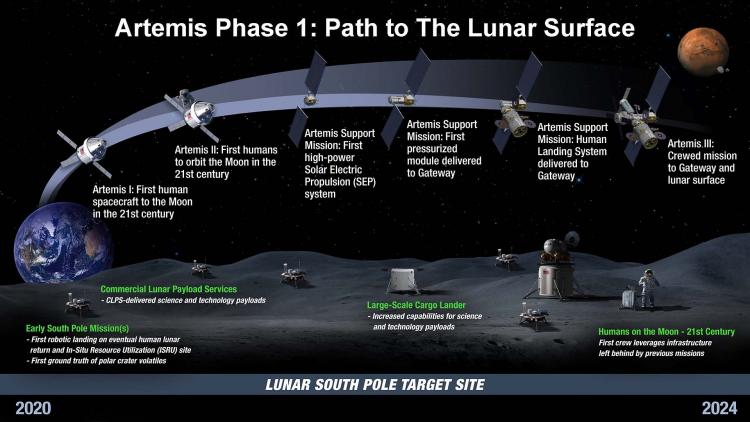Cosmic Curiosities
“When you look at the origins and evolution of life on Earth, it's been severely affected by asteroid impacts through history."
- Rusty Schweikart, Apollo 9 Astronaut
By the end of 2021, NASA plans to launch three significant missions. One will help protect us from a big impact; another starts the journey to have astronauts walk on the moon again. The last one will send into orbit the world’s most powerful space telescope.
Safer Space
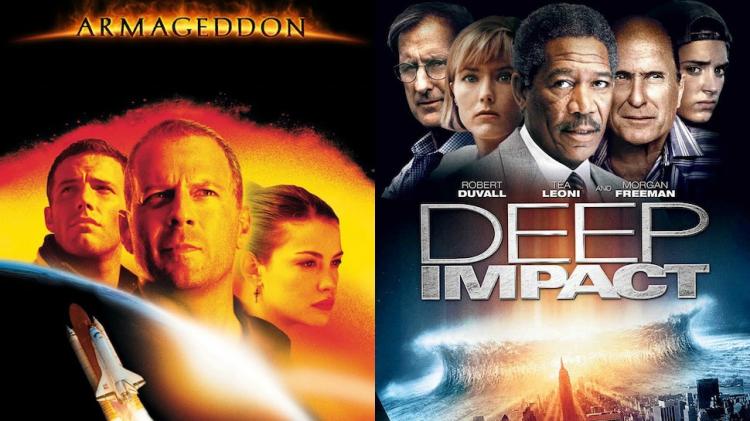
Back in 1998, two movies premiered about deadly collisions from space: Armageddon and Deep Impact. Although the movies were a little loose with the facts, people were suddenly wondering if the threat was real. Could life on Earth be in danger? The answer is yes. The main question is not if, but when, a big asteroid or comet will be on a collision course with Earth?
The Earth is pelted every day by space debris. Almost all of this is very small—dust grains—and no threat to humans. We can see these miniscule impacts every clear night as meteors, or “falling stars.” Bigger impacts make the headlines.
Back in February 2013, a 70-foot space rock raced through the skies over Chelyabinsk, Russia. While some small pieces hit the Earth as meteorites, it was the ferocious shockwave that caused widespread injuries. The pressurized air was so intense it blew windows out all over town. The flying glass injured about 1,000 people; no one died from the blast. In June of 1908, a huge 200-foot meteoroid exploded before impact over Tunguska, Siberia. This explosion was close enough to the ground that trees flattened more than 800 square miles of forest. That’s almost as big as Milwaukee County! Two men and several reindeer died from the disastrous event.
There are more than 10 reliable reports of human casualties from meteorite impacts throughout the last 2,500 years. Most of these are from Europe and China. There possibly could be more deaths if any tsunamis were caused by an impact from space. None of these impact events were cataclysmic on a large scale. However, we only went back in time a few thousand years. Given long enough time scales, more devastating events will take place. We can easily recall the mammoth rock that wiped out the dinosaurs and 75% of all living species 66 million years ago.
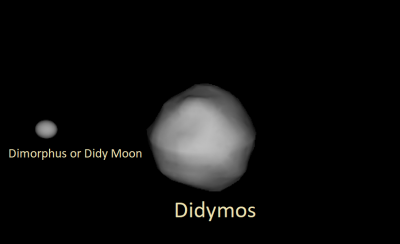 While the dinosaurs did not have a space agency to protect themselves, we do.
While the dinosaurs did not have a space agency to protect themselves, we do.
In late November 2021, NASA plans to launch the DART mission to the Didymos asteroids. DART stands for Double Asteroid Redirection Test. After launch, it will reach the two asteroids in late 2022. Didymos is the large rock—about a half mile in diameter. The smaller is named Dimorphos—or sometimes “Didy Moon.” It is five times smaller at about 500 feet—or the size of Lambeau Field.
The goal is to smash tinier Didymos with a projectile spacecraft about the size of a refrigerator—but weighing 700 pounds. The impact speed will be about four miles per second. That’s eight times faster than the fastest bullet.
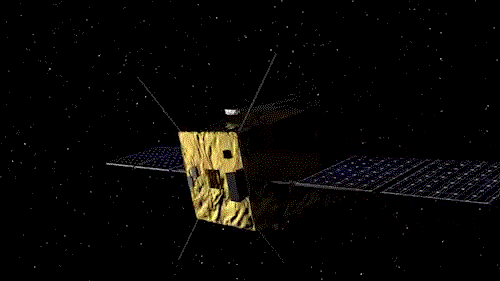 If all goes well, the little asteroid (Dimorphus) will have a slightly new orbit as it goes around the larger Didymos. How slight? Right now, its orbital time is 12 hours. If successful, the change will be only a few minutes. A mission called Hera by the European Space Agency will arrive five years later and find out if the DART mission worked.
If all goes well, the little asteroid (Dimorphus) will have a slightly new orbit as it goes around the larger Didymos. How slight? Right now, its orbital time is 12 hours. If successful, the change will be only a few minutes. A mission called Hera by the European Space Agency will arrive five years later and find out if the DART mission worked.
Why all the fuss for such a small change in orbit? If an asteroid’s path was ever discovered to impact the Earth in the future, even a tiny deflection of orbit could alter its trajectory just enough to stop a global catastrophe.
Artemis Goes to the Moon
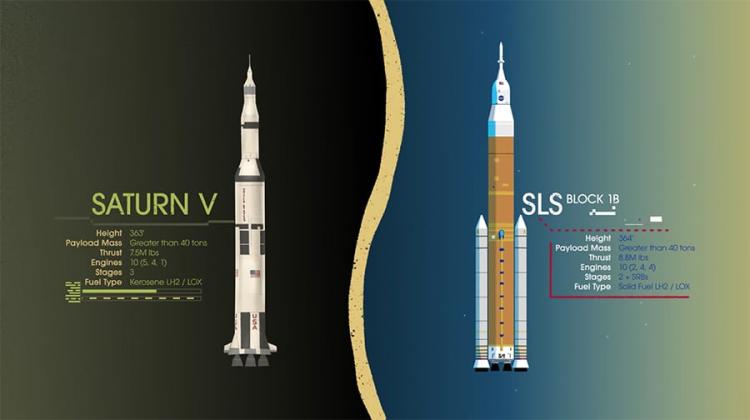
When you think of NASA’s Artemis program to the moon, it’s safe to think of Apollo. Sure, it’s now over 50 years later, but the power needed to escape Earth’s gravity is still the same.
To reach Earth’s escape velocity at seven miles per second, you need a big rocket — a tall one, more than 30 stories high. It means topping off the “gas” tank with over 5 million pounds of fuel! In fact, more than 80% of the entire weight of the rocket was fuel. Back in Apollo-time, it was called Saturn V. This time it will be the Space Launch System (SLS).
While we are not in a space-race with anyone specifically, one might wonder why are we going to the moon? Here is NASA’s answer:
“We’re going back to the moon for scientific discovery, economic benefits, and inspiration for a new generation of explorers: the Artemis Generation. While maintaining American leadership in exploration, we will build a global alliance and explore deep space for the benefit of all.”
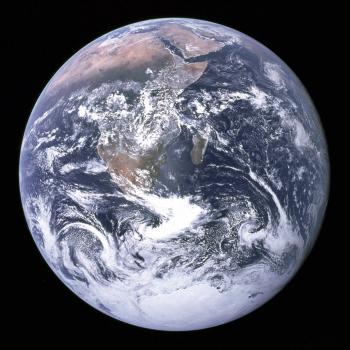 It’s important to remember these reasons and goals. One can look at Apollo as a political space-race with the Soviet Union, but the bigger picture reveals much more.
It’s important to remember these reasons and goals. One can look at Apollo as a political space-race with the Soviet Union, but the bigger picture reveals much more.
We got to see the Earth whole, blue, and beautiful. We learned about the dedication, expertise, and focus it took. We witnessed not just the experiences of the astronauts, but the 400,000 people who worked and made it possible for 12 people to make footprints on the moon — people like Katherine Johnson; she was so good at math, people called her a “computer.” She first helped NASA put an astronaut into orbit and then to the moon. Watch the movie Hidden Figures to find out more about her amazing life!
 So when will Artemis I launch? Blast off is still planned near the end of 2021, but it may be pushed to early 2022. Artemis I is an uncrewed test—no astronauts will be sitting in the Orion spacecraft, which sits atop the Space Launch System rocket.
So when will Artemis I launch? Blast off is still planned near the end of 2021, but it may be pushed to early 2022. Artemis I is an uncrewed test—no astronauts will be sitting in the Orion spacecraft, which sits atop the Space Launch System rocket.
Artemis I will place Orion into a lunar orbit and then return it to Earth. It will be the first test flight. The mission is planned for 25 days with Orion in lunar orbit for about six days.
NASA’s graphic below reveals the overall plan for subsequent missions to the moon. Gateway is the base area near the moon’s south pole. While 2024 is the target year to return people to the lunar surface, many estimate it will be at least a year or two later.
Stay tuned!
Better Eyes on Deep Skies
It’s been said there have been two great transformations in astronomy.
The first was when Galileo pointed his telescope toward the sky and saw things no one had seen before. Our view of the cosmos—and our place in it—changed dramatically with all his discoveries. The second paradigm shift was the Hubble Space Telescope. Launched in 1990 and fitted with “glasses” in 1993, Hubble gave us breathtaking imagery and countless discoveries. And it’s still going after more than 30 years!
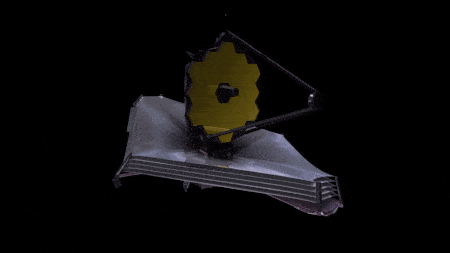 The next anticipated “giant leap” in cosmic detection is the James Webb Space Telescope. Many call it JWST, or just Webb. It will be the largest and most powerful space telescope ever built. Webb will collect light from the most-distant galaxies yet. It will explore how these gargantuan star-cities first came to be and evolved over time. The giant mirror is set to explore exoplanets by looking for chemical signatures for possible life, like detecting oxygen in the atmosphere. Webb will even explore our own planets and also study planets within our own solar system. JWST is now scheduled for launch on December 18, 2021. There have been many delays in this 10 billion dollar project. It started way back in 1996 with a 2007 scheduled launch.
The next anticipated “giant leap” in cosmic detection is the James Webb Space Telescope. Many call it JWST, or just Webb. It will be the largest and most powerful space telescope ever built. Webb will collect light from the most-distant galaxies yet. It will explore how these gargantuan star-cities first came to be and evolved over time. The giant mirror is set to explore exoplanets by looking for chemical signatures for possible life, like detecting oxygen in the atmosphere. Webb will even explore our own planets and also study planets within our own solar system. JWST is now scheduled for launch on December 18, 2021. There have been many delays in this 10 billion dollar project. It started way back in 1996 with a 2007 scheduled launch.
The telescope is named after James Webb, head of NASA from 1961 to 1968. While he led the Mercury, Gemini, and Apollo missions that led to the first moon-landing, Webb was instrumental in keeping NASA focused on science and astronomy. NASA telescopes are usually named after scientists, but Webb’s influence as a leader and administrator was considered so strong, the telescope was named after him. The telescope has many international partners, including the European Space Agency and the Canadian Space Agency.
Webb will look at the universe in the infrared. Human eyes do not see this part of the electromagnetic spectrum but we often can feel it as heat energy.
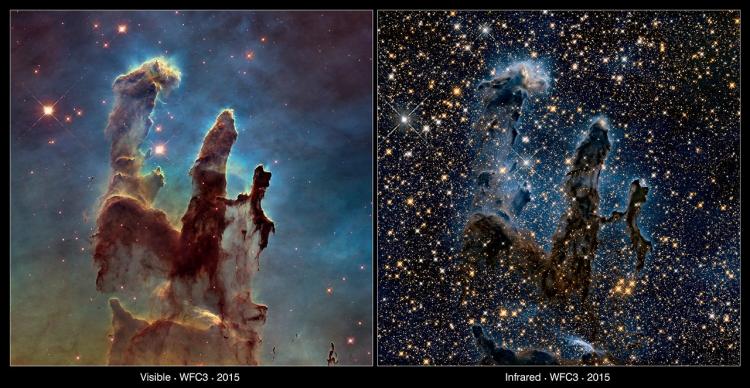
These longer wavelengths of infrared light will have even greater sensitivity than Hubble. Hubble is no slouch, of course; its infrared prowess can be seen in the above images of the “Pillars of Creation,” or the eagle nebula. This collection of gas and dust is making new stars about 7,000 light years away in the constellation Serpens.
The original pillars image in visible light came out in 1995 and showcased the amazing sharp eye of Hubble. Last year, the Hubble team revealed the pillars in infrared light. In this exquisite view, we can see baby stars being formed. JWST will be able to see right through these dust clouds to many more stars and planets being born.
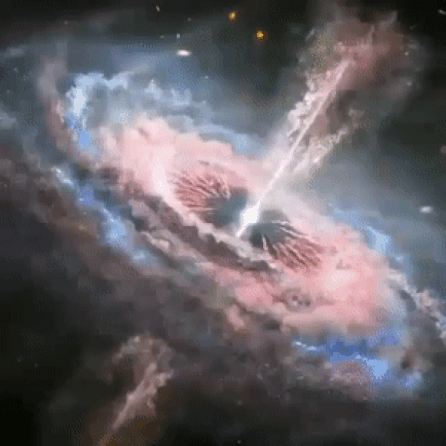 Another cosmic mystery awaiting the Webb telescope is to answer questions of supermassive black holes formed at the center of galaxies. Currently, we’re not sure what came first: Did black holes cause the galaxies to form, or vice versa? Again, JWST will pierce through the galactic dust clouds and find the answer to the origin of mammoth black holes.
Another cosmic mystery awaiting the Webb telescope is to answer questions of supermassive black holes formed at the center of galaxies. Currently, we’re not sure what came first: Did black holes cause the galaxies to form, or vice versa? Again, JWST will pierce through the galactic dust clouds and find the answer to the origin of mammoth black holes.
Riddles of dark matter or energy will become less foggy thanks to the Webb Space Telescope. It will pinpoint better maps of where dark matter is located by its gravitational influences. For dark energy, Webb hopes to learn more about the history of the acceleration of the early universe. There will be Webb discoveries that we can't imagine today!
Sky Sights
Click maps to enlarge.
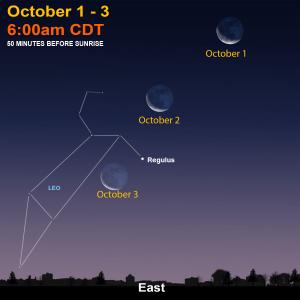 In early autumn, you can see a sign of spring in the morning sky—Leo the Lion. This constellation becomes visible low in the east in the pre-dawn sky in early October. In spring, you see the stars of Leo in the same position right after sunset. Look for the Moon to pass the bright star Regulus from October 1-3.
In early autumn, you can see a sign of spring in the morning sky—Leo the Lion. This constellation becomes visible low in the east in the pre-dawn sky in early October. In spring, you see the stars of Leo in the same position right after sunset. Look for the Moon to pass the bright star Regulus from October 1-3.
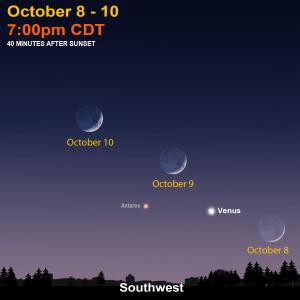 Super-bright Venus and the crescent Moon make a dazzling sight from October 8-10.
Super-bright Venus and the crescent Moon make a dazzling sight from October 8-10.
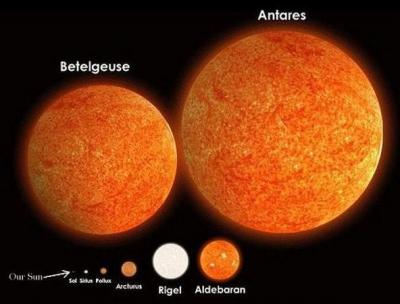 Look for the red giant Antares nearby. Antares is one of the biggest stars in the galaxy. It is 700 times the diameter of the Sun!
Look for the red giant Antares nearby. Antares is one of the biggest stars in the galaxy. It is 700 times the diameter of the Sun!
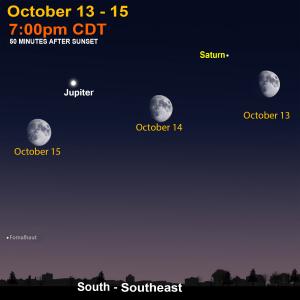 Jupiter and Saturn are joined by a near-full moon from October 13-15. These two gas giant planets will be visible in the evening sky through early 2022.
Jupiter and Saturn are joined by a near-full moon from October 13-15. These two gas giant planets will be visible in the evening sky through early 2022.
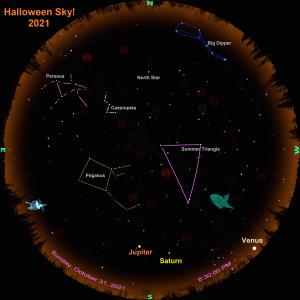 Check out a beautiful Halloween sky. You never know what you might see!
Check out a beautiful Halloween sky. You never know what you might see!
October Star Map
Sign Up
Receive this newsletter via email!
Subscribe
See the Universe through a telescope
Join one of the Milwaukee-area astronomy clubs and spot craters on the Moon, the rings of Saturn, the moons of Jupiter, and much more.
Follow Bob on social media
Twitter: @MPMPlanetarium
Facebook: Daniel M. Soref Planetarium


